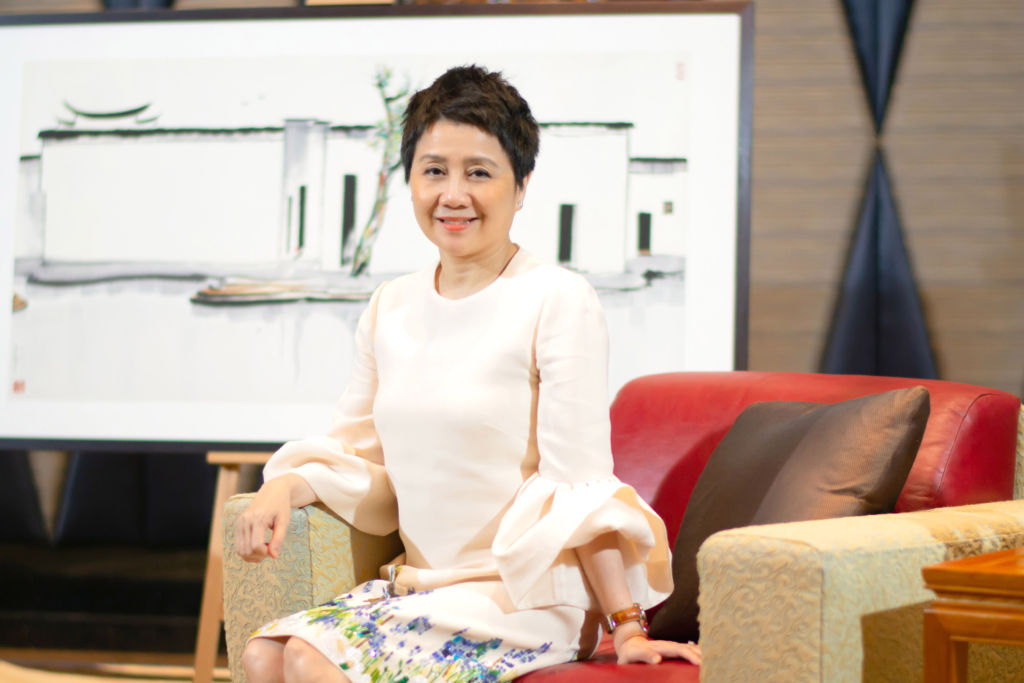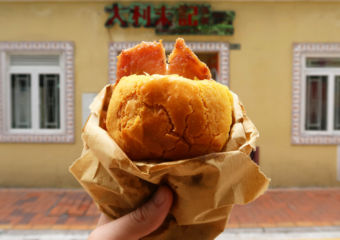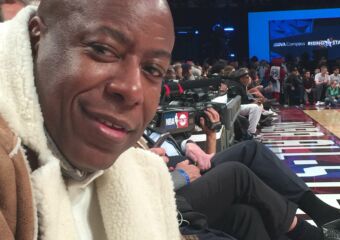Through her many public and private duties, which include being a member of the Legislative Assembly of Macau, Angela Leong has had an immeasurable impact on Macau’s development, achievements and growth into a city for creative industries and a cultural hub in Asia. We had the honor of speaking to the awarded female entrepreneur at the helm of Sociedade de Turismo e Diversões de Macau (STDM) and find out about how she perceives Macau as an art and cultural exchange platform, the role of women in business and her private art collection.
You’ve contributed greatly to Macau’s tourism development. What are the recent changes in the city’s positioning as a destination that you’d like to point out?
In recent years, Macau has been striving to expand in non-gaming industries, such as in the case of “Creative City of Gastronomy” and “Cultural Macau”, which are wide-ranging and helped to attract different types of visitors to visit Macau. In a small place such as Macau, with the convenience of geographical location and history background, the combination of Chinese and Western cultures comes naturally, and the local art and culture are constantly improving. From “Art Macao”, you can see that with the great support from the SAR government, the image of “Cultural Macau” continue to grow and work towards becoming a cultural exchange platform between Chinese and Western cultures.
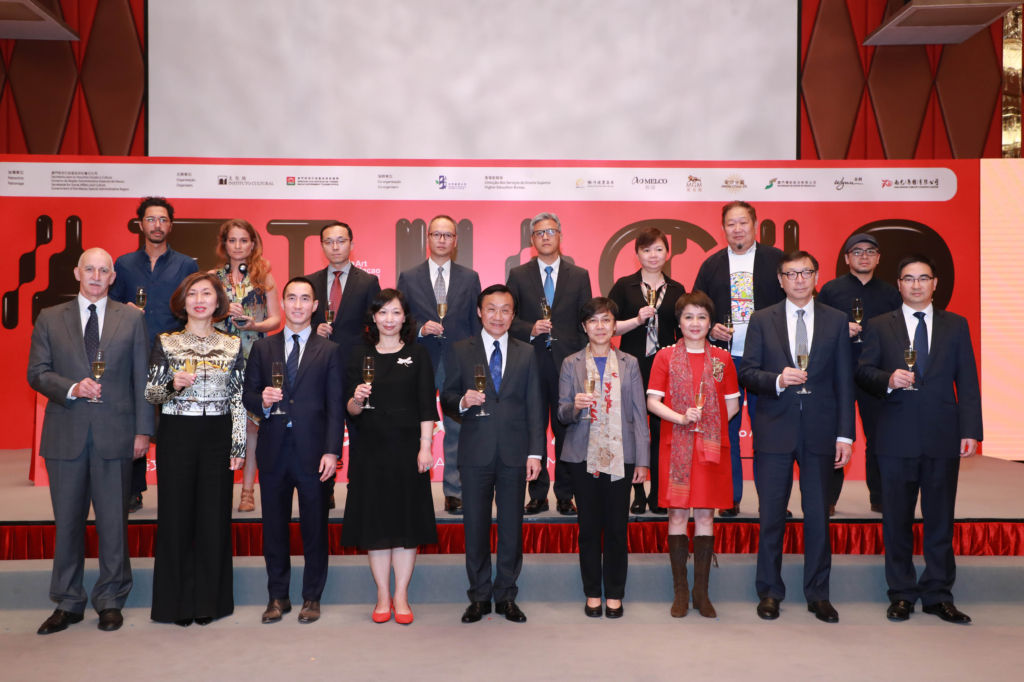
Angela Leong (in red) at the Art Macao press conference
Art Macao, the mega international arts and cultural event, currently in its first edition is a huge success. What effect will Art Macao bring to the city and its population?
Mobilizing resources from all participating parties, including ourselves, different forms of visual and performing arts were put together. We bring the world of art to Macao and at the same time, show the world what art of Macau is like. One of the aims of “Art Macao” is to enable visitors to enjoy a wide variety of art all in Macau at one time. The audience can experience the essence of Chinese and Western art from all kinds of different art exhibitions and showcase Macau’s unique blend of Chinese and Western culture. This will, in turn, generate new driving forces for the local Macau residents to explore and develop the art and culture landscape.
What impact do you expect Art Macao to have on Macau’s cultural outlook and
tourism?
You can see from “Art Macao” that the Macau government has been paying attention and exerting efforts into the importance of development in the arts and culture industries. Joining forces with other concessionaires and participating parties, they work in synergy bringing Macau’s rich traditional culture to daily living, consolidating Macau’s status as a multicultural city and developing into an art industry center, I believe the outlook is optimistic.
Macau is becoming an art hub in Asia, a creative city, and it is further strengthening its role as a cultural exchange platform in the Greater Bay Area. What is the contribution of such events in the local economy’s diversification?
Events such as “Art Macao” show that the government is willing to invest resources to expand and support Macau’s role as a cultural exchange platform in the Greater Bay Area. These events also lead to growing opportunities and demands for local products and service industries, which helps to diversify the development of the Macau economy.
With Art Macao comes growing opportunities for local artists. With Art Macao being an
international festival, will it bring local artists further visibility in the global art scene?
“Art Macao” certainly offers a great chance for local artists to be seen in the global art scene. On the international level, “Art Macao” attracts visitors from all over the world to enjoy art all in one place. With this, we are also able to showcase Macau’s local talent to the world and it is certainly a great chance for the world to see what Macau has to offer.
What is the role of curated art in the hospitality business? How does it enhance the
hotel guest experience?
From the second you step into a hotel, you would notice art pieces placed in many different spots; whether in the lobby to guestroom corridors or inside the hotel rooms itself. We should remember that art is not just decorations. Placing art–curated art in a hotel can serve multiple purposes. Not only does it help convey the brand’s image, but it also further claims to a local provenance. Moreover, art collections can create conversations, along with responding to the desire of guests to project who they are by where they stay. With the first-ever art piece collected by Dr. Stanley Ho in 1970, SJM recognized the need to build the city with a stronger art, heritage and culture presence in order to highlight our strengths and unique characteristics, whilst building on our successes and preparing for a thriving cultural scene. It would be great if our art collection could spark interest for the visitors in the rich cultural heritage of Macau’s art.
As a distinguished female entrepreneur, you’ve been crucial in the city’s overall development. Could you please tell us about the challenges you’ve faced in your career – or still face? – and how did you overcome them?
Even after all these years, all of the “challenges” I face, I see them as an opportunity to grow and an experience to learn from. One thing to note is that you should always stay focused and positive!
How would you describe the role of women when it comes to Macau’s current business context? What changes could you identify in this role in recent years?
Following the global trend and the importance of gender equality, Macau, being an international hub, in recent years, has also seen many women climbing up the corporate ladder and taking up roles in senior management. Having women climbing up in the corporate ladder offers a diversity in the workplace, which fosters creativity and innovation that helps push an organization forward.
You are an art enthusiast and collector. Could you share with our readers your favorite artists?
One of my favorite artists is Mr. Wu Guanzhong. He is known for works that combined traditional Eastern ink wash drawing with Western oil painting. In July, we were delighted to hold a special exhibition as a tribute to his 100th Birth Anniversary, entitled with one of his famous sayings – “Unbroken Kite Strings”.
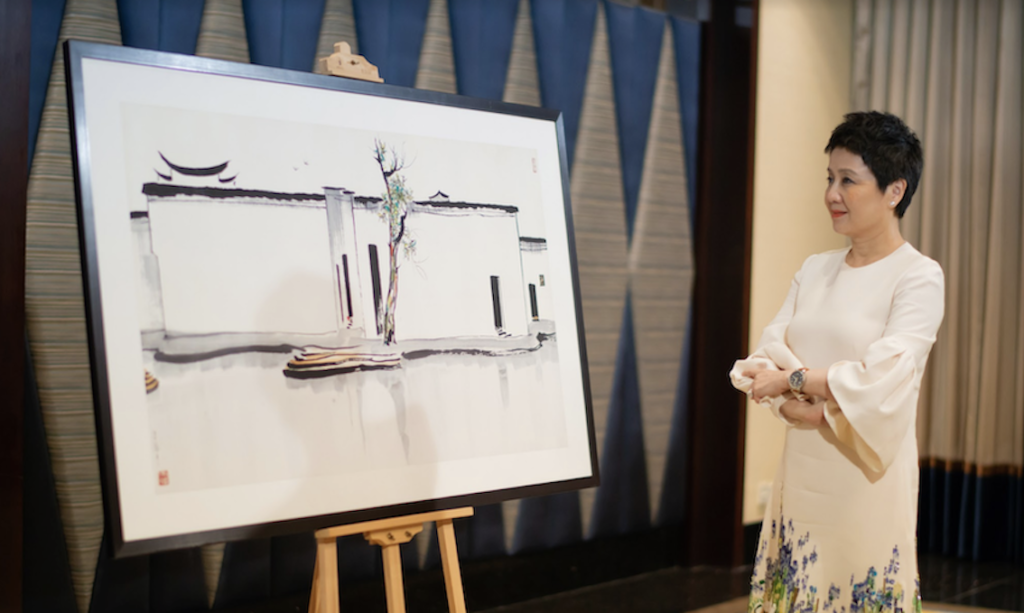
Angela Leong and Two Twin Swallows by Wu Guanzhong
Would you be able to name some of the pieces you treasure the most in your personal art collection?
Twin Swallows by Wu Guanzhong would be one that I treasure the most from my personal art collection. It marks the journey of which Wu explores how best to blend the East and the West in art. He succeeded by projecting his essentially Eastern spirit and his affection for his native land through geometric simplicity and minimalism that are typical of Mondrian. Two simple strokes represent the twin swallows. Are they lingering or are they flying up and above? Are they just passers-by or are they the main focus? It is all up to the viewers with boundless imaginations.

